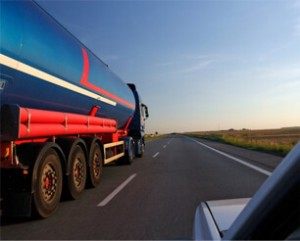
Federal Requirements
The Federal Motor Carrier Safety Administration (FMCSA) is the governing body that regulates motor carrier interstate commerce. So, if you’re hauling any type of cargo across state lines, the FMCSA regulations apply to you. Here’s the breakdown:
Non-Hazardous Cargo
• $300,000 for non-hazardous cargo with gross vehicle weight under 10,001 lbs.
• $750,000 for non-hazardous cargo with gross vehicle weight above 10,001 lbs.
Hazardous Cargo
All motor carriers hauling hazardous cargo are required to follow FMCSA guidelines. These guidelines do apply to all motor carriers, regardless if they’re operating interstate or only intrastate. Hazardous cargo is defined as: explosives; flammable, non-flammable, or toxic gases; flammable liquids; flammable solids; oxidizing substances; poisonous and infectious substances; radioactive materials; and corrosive substances.
• $5,000,000 for hazardous cargo with gross vehicle weight under 10,001 lbs.
• $5,000,000 for hazardous cargo with gross vehicle weight above 10,001 lbs.
• $1,000,000 for private for-hire trucks carrying hazardous cargo with a gross vehicle weight above 10,001 lbs.
Passengers
• $5,000,000 for motor carriers with 16 or more passengers (including the driver).
• $1,500,000 for motor carriers with 15 or fewer passengers (including the driver).
• Exemptions: school buses; taxi cabs with less that seven passengers; commuter vehicles with less than 16 passengers.
The Federal Motor Carrier Safety Administration (FMCSA) is the governing body that regulates motor carrier interstate commerce. So, if you’re hauling any type of cargo across state lines, the FMCSA regulations apply to you. Here’s the breakdown:
Non-Hazardous Cargo
• $300,000 for non-hazardous cargo with gross vehicle weight under 10,001 lbs.
• $750,000 for non-hazardous cargo with gross vehicle weight above 10,001 lbs.
Hazardous Cargo
All motor carriers hauling hazardous cargo are required to follow FMCSA guidelines. These guidelines do apply to all motor carriers, regardless if they’re operating interstate or only intrastate. Hazardous cargo is defined as: explosives; flammable, non-flammable, or toxic gases; flammable liquids; flammable solids; oxidizing substances; poisonous and infectious substances; radioactive materials; and corrosive substances.
• $5,000,000 for hazardous cargo with gross vehicle weight under 10,001 lbs.
• $5,000,000 for hazardous cargo with gross vehicle weight above 10,001 lbs.
• $1,000,000 for private for-hire trucks carrying hazardous cargo with a gross vehicle weight above 10,001 lbs.
Passengers
• $5,000,000 for motor carriers with 16 or more passengers (including the driver).
• $1,500,000 for motor carriers with 15 or fewer passengers (including the driver).
• Exemptions: school buses; taxi cabs with less that seven passengers; commuter vehicles with less than 16 passengers.
State Requirements
If you are a motor carrier of non-hazardous cargo operating within a single state’s boundary, then you are an intrastate carrier subject to that state’s insurance requirements. Although most states have adopted the federal standards of limited liability insurance, some states, like Florida, actually have higher requirements for intrastate motor carriers. The best way to find out what’s required is to visit your state’s Department of Transportation (DOT) website. There you will find a breakdown of insurance requirements based on vehicle weight and cargo, as well as any addition information you might need as to how and where to file forms.
Is Limited Liability Enough?
The FMCSA states that the answer to that question is a resounding “No.” According to FMCSA, of the 500,000 accidents involving tractor trailers on America’s roadways every year, about 45% exceed the amounts of limited liability insurance. As a result, the FMCSA has been lobbying congress to increase the minimum liability amounts required for motor carriers. There are several reasons behind the proposed increase, but the main argument is that the rising cost of medical treatment isn’t reflected in the standards set in the 1980s.
There are supplemental insurance policies that help offset the increased costs that a motor carrier or owner operator faces in the event of an accident. These policies include increased cargo and trailer insurance, occupational accident insurance, environmental insurance, and increased public/personal liability. With these additional insurance policies in your arsenal, you can make sure your business is protected on America’s highways.

